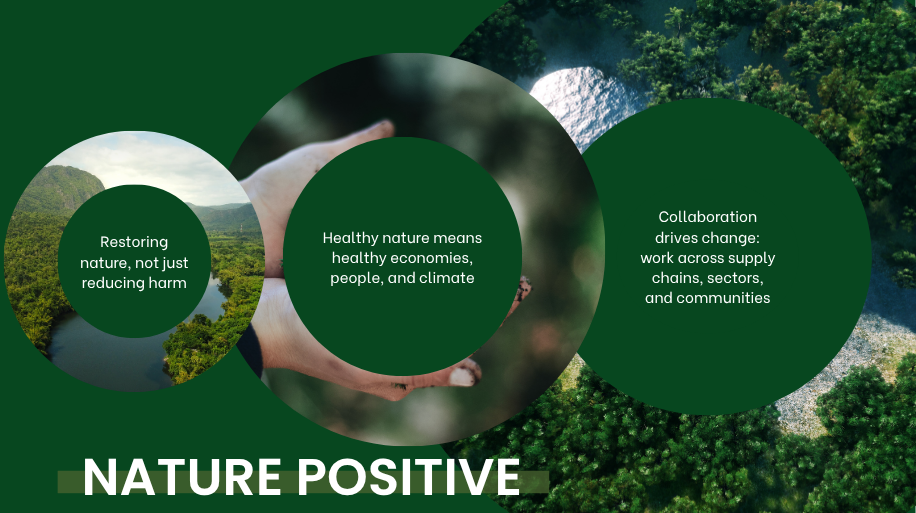Everything Is Connected: A New Way to Think About Business and Nature
Leaders today confront a level of uncertainty far greater than previous eras. From climate-related disruptions impacting supply chains to public health issues which affect workforce productivity, the degradation of natural systems directly translates into operational risks and diminished human capital. Amidst this complexity, a growing number of forward-thinking leaders are asking deeper questions to focus on resilience and the creation of long-term value. Within this dialogue, you may have encountered a term gaining significant traction in discussions: nature-positive. This article is an invitation to understand what nature-positive means, why it matters for you, and how embracing its principles can unlock new perspectives on the future of business.
In traditional economic models, nature has often been relegated to the role of “natural capital”. It is a seemingly endless reservoir of resources to be extracted, managed, or, at best, offset. It has largely been treated as a passive backdrop against which human enterprise unfolds. However, this perspective fundamentally misunderstands nature’s role. From the clean water that fuels our industries to the weather patterns that enable agriculture, and the healthy soil and rich biodiversity that underpin countless processes, these natural elements are integral, active components of our immediate environment. Every resource consumed, every ecosystem altered, and every pollutant released creates a feedback loop that ultimately undermine the very foundations of economic stability and societal well-being.
This brings us to a crucial understanding that the health of natural systems is inextricably linked to human well-being and economic stability. When we degrade ecosystems, pollute our air and water, or diminish biodiversity, we are undermining the core elements that support our societies and our businesses. The concept of nature-positive acknowledges this shared reliance and the direct consequences of our environmental interactions on ourselves.
What Does Nature-Positive Mean?

Nature-positive is the idea that our actions should not just protect, but actively restore and enhance nature. This means business operations should create a net benefit for biodiversity and natural systems, moving beyond harm reduction to regeneration and restoration. It simply means giving back to nature more than we take, and it’s a shift from doing “less bad” to doing “more good”. It’s about conserving our precious wildlife and habitats, bringing damaged ecosystems back to life, and making the natural world stronger and more vibrant.
Let’s look at it this way:
- Reversing the Damage, Not Just Slowing It Down
Being nature-positive means more than just reducing harm like minimising pollution or using fewer natural resources. It’s about taking active steps to improve nature, for instance, planting trees or restoring wildlife habitats.
- Investing in Ecosystem Restoration
Businesses and communities can restore wetlands that reduce flood risks, revive forests that capture carbon, or clean up rivers to support biodiversity and healthy water systems.
- Building a Healthier Planet
Nature-positive action supports global efforts to halt and reverse nature loss, helping ensure a healthier, more stable planet for people, businesses, and future generations.
- Everyone has a Role
No single company or organisation can achieve this alone. It requires collaboration across industries, governments, supply chains, and communities.
- Focusing on Possibility and Progress
At its core, the nature-positive movement is about holistic and positive contributions. It invites us to see nature as an opportunity to create thriving ecosystems that support both the environment and human well-being.
The idea of being nature-positive pushes companies to proactively address mounting nature-related risks, build robust and sustainable supply chains, and seize significant early-mover advantages in the transition to a nature-positive economy. The concept calls for collective action spanning various sectors, value chains, and regions, signaling a powerful move away from siloed corporate efforts towards collaborative solutions for a shared environmental future.
Why Is This Conversation Growing?
The increasing focus on being nature-positive marks a shift in the business world. It’s moving beyond superficial sustainability efforts to a deep, strategic re-evaluation of how businesses operate. In our volatile economy, which is increasingly shaped by climate disruption, biodiversity loss, and resource scarcity, protecting nature is no longer merely an ethical consideration. Instead, it has become a direct route to achieving strategic advantage, resilience, and long-term financial stability. Businesses are now starting to realise that sustainability is not about managing public perception or ensuring regulatory compliance. Instead, it’s about future-proofing their operations and remaining relevant in a rapidly changing world.
This transformative shift directly challenges the outdated “growth-at-any-cost” mindset. It champions regenerative business models that create shared value, rather than relying on resource depletion and zero-sum competition. Adopting this approach requires companies to thoroughly assess their dependencies on nature and their environmental impacts, establish measurable goals, and commit to transparent reporting on their progress. While concerns about “greenwashing” are certainly valid, the sheer scale and urgency of environmental risks mean that this transition has become a competitive necessity.
Nature-positive approaches are not just good for the planet, they’re also good for business. The World Economic Forum (WEF) estimates that implementing nature-positive policies could unlock $10 trillion in new business value annually and create 395 million jobs by 2030. Discover more from WEF’s insights here. For business leaders focused on sustainable growth, innovation, and long-term competitiveness, this presents an opportunity to reimagine business models through the lens of regeneration. The companies that embrace this transformative shift early will mitigate mounting risks and lead the market transformation that lies ahead.
Valuing What Matters: Expanding our Definition of Profits
Embracing a nature-positive approach poses significant challenges for business leaders, who are often driven by short-term profits and immediate growth targets. It’s difficult to justify investments in biodiversity or ecosystem health when their financial returns are not immediately obvious. Furthermore, many companies grapple with knowledge gaps, inconsistent data, or feel overwhelmed by the complexity of measuring their environmental impact.
However, ignoring nature risks is a costly mistake. Environmental decline can destabilise supply chains, restrict resource availability, lead to regulatory issues, and could harm a company’s reputation. The key lies in redefining “profit” to include the health of natural systems, acknowledging that nature is an integral part of the balance sheet. Viewing nature-positive actions as a powerful driver for long-term value and resilience enables businesses to deeply integrate sustainability into their core strategy, including how they manage profit, risk, and output. While this transition may be challenging, it’s becoming more and more important.
The escalating degradation of nature introduces quantifiable risks to global supply chains, human capital, and overall economic stability. Companies that continue to ignore these signals will become increasingly vulnerable. Conversely, those that act proactively will secure a stronger market position, enhance operational resilience, and gain access to a growing green investment landscape. Ultimately, a commitment to nature-positive outcomes is one of the most compelling evidence of responsible and adaptive leadership.
The First Steps Towards Being Nature-Positive
To become nature-positive, business leaders need to systematically evaluate their relationship with the natural world. This begins by identifying your dependencies and impact on nature. Start by mapping exactly how your business relies on natural resources e.g., raw materials and land, and how your operations, from emissions and waste to land use, affect ecosystems. By assessing how your operations depend on and impact natural systems, leaders can then develop a strategy with clear, measurable goals aligned to global frameworks.
A practical starting point for companies aiming to transition toward a nature-positive business model is adopting the Taskforce on Nature-related Financial Disclosures (TNFD) framework alongside the Biodiversity Impact Metric. The TNFD offers a standardised approach for companies to understand and report how their operations affect nature, depend on it, and the risks involved. By using this framework, businesses can more easily weave biodiversity considerations into their long-term plans, manage risks more effectively, and communicate better with investors. All in all, the framework enables companies to support global biodiversity targets and discover new opportunities in nature restoration and sustainable resource use. The Biodiversity Impact Metric is a data-driven tool designed to quantify a company’s total impact on nature, including ecosystems, species, and habitats. This provides a foundation for businesses to set measurable biodiversity targets and track their performance. It helps companies pinpoint where their greatest impacts are, assign responsibility, and prioritise effective mitigation strategies to improve their overall environmental performance. When used together, TNFD and the Biodiversity Impact Metric offer a structured and actionable foundation for businesses to enhance transparency and manage risks in the shift toward a nature-positive future.
For businesses ready to take nature-positive steps, a strategic focus on enhancing urban natural infrastructure within their properties, optimising commuting and work practices, and actively investing in local community nature projects offers significant returns. This involves the following strategies you can implement:
1. Create “Nature Pathways”: Look at your office grounds and surrounding areas for opportunities to build interconnected green spaces that support local biodiversity. By creating a series of well-planned gardens or tree-lined walkways, companies can extend or link their sites to to existing natural areas. These pathways promote urban biodiversity and simultaneously provide restorative spaces that enhance employee health and satisfaction.

2. Design for “Living Buildings”: Invest in features that allow your building to work with nature, not against it. Incorporate features such as green roofs, vertical gardens (living walls), and integrated native planting throughout indoor and outdoor spaces. These elements improve energy efficiency by moderating building temperatures, reducing rainwater runoff, and provide refuge for urban wildlife. In addition to ecological benefits, these features demonstrate visible corporate leadership in sustainability and can improve employee morale and brand reputation.

3. Rethink Commuting and Work Practices: Actively encourage and reward employees for choosing low-impact ways to get to work, such as providing secure bike storage and shower facilities for cyclists. Flexible working arrangements can directly reduce daily energy consumption in the office and urban congestion, while improving employee satisfaction and productivity by cutting down on commuting stress.

4. Invest in Shared Natural Prosperity: Businesses can play a crucial role in enhancing the natural environment of their local communities. Dedicate company time for employees to participate in hands-on nature projects which could involve planting trees, maintaining community gardens, or cleaning up local waterways. Seek partnerships with local governments or environmental NGOs on larger-scale projects to amplify impact and create a more resilient ecosystem.

Conclusion: Your Role in a Connected Economy
No business operates in isolation. Every product, every service, and every transaction is fundamentally tied to the natural systems that allow us to exist. Business leaders must acknowledge that the health of a company is deeply connected to the health of the planet. Defining success by traditional metrics of profit and growth is proving to be a dangerously narrow perspective.
While the journey to nature positivity is complex and involves challenging trade-offs, it is a critical test of leadership. It takes forward-thinking leaders to put the planet’s long-term health ahead of immediate profits, in order to forge a meaningful legacy of resilience and sustainability. Fortunately, there are practical tools, frameworks, and collaborative initiatives available to guide businesses through this transformation, making implementation both achievable and impactful. While inaction carries significant risks, proactive and determined efforts offer a powerful chance for nature to regenerate and thrive.
The prevailing question might be, “Why should I act now?” The answer is simple: a proactive approach to nature offers clear differentiation and greater resilience in competitive markets, while also unlocking easier access to growing green funding. We should not be waiting for governments to mandate change. Shareholders and stakeholders are already increasingly aware of nature-related risks and expect robust action plans. Companies can also capitalise on early commercial opportunities in the transition to a nature-positive economy. Our current trajectory demands a decisive shift beyond superficial sustainability efforts toward measurable action that actively regenerate rather than deplete. Being nature-positive is rapidly becoming the measure of a company’s long-term resilience, market relevance, and responsibility.
Stay ahead with exclusive insights! Sign up for our mailing list and never miss an article. Be the first to discover inspiring stories, valuable insights and expert tips – straight to your inbox!




